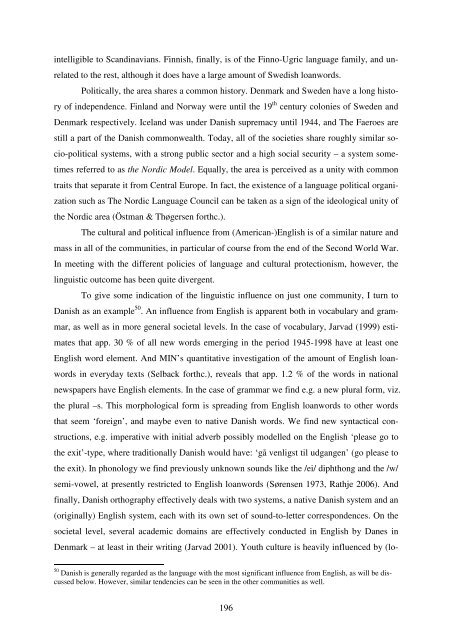Hør dog hvad de siger - Note-to-Self: Trials & Errors
Hør dog hvad de siger - Note-to-Self: Trials & Errors
Hør dog hvad de siger - Note-to-Self: Trials & Errors
You also want an ePaper? Increase the reach of your titles
YUMPU automatically turns print PDFs into web optimized ePapers that Google loves.
intelligible <strong>to</strong> Scandinavians. Finnish, finally, is of the Finno-Ugric language family, and un-<br />
related <strong>to</strong> the rest, although it does have a large amount of Swedish loanwords.<br />
Politically, the area shares a common his<strong>to</strong>ry. Denmark and Swe<strong>de</strong>n have a long his<strong>to</strong>-<br />
ry of in<strong>de</strong>pen<strong>de</strong>nce. Finland and Norway were until the 19 th century colonies of Swe<strong>de</strong>n and<br />
Denmark respectively. Iceland was un<strong>de</strong>r Danish supremacy until 1944, and The Faeroes are<br />
still a part of the Danish commonwealth. Today, all of the societies share roughly similar so-<br />
cio-political systems, with a strong public sec<strong>to</strong>r and a high social security – a system some-<br />
times referred <strong>to</strong> as the Nordic Mo<strong>de</strong>l. Equally, the area is perceived as a unity with common<br />
traits that separate it from Central Europe. In fact, the existence of a language political organi-<br />
zation such as The Nordic Language Council can be taken as a sign of the i<strong>de</strong>ological unity of<br />
the Nordic area (Östman & Thøgersen forthc.).<br />
The cultural and political influence from (American-)English is of a similar nature and<br />
mass in all of the communities, in particular of course from the end of the Second World War.<br />
In meeting with the different policies of language and cultural protectionism, however, the<br />
linguistic outcome has been quite divergent.<br />
To give some indication of the linguistic influence on just one community, I turn <strong>to</strong><br />
Danish as an example 50 . An influence from English is apparent both in vocabulary and gram-<br />
mar, as well as in more general societal levels. In the case of vocabulary, Jarvad (1999) esti-<br />
mates that app. 30 % of all new words emerging in the period 1945-1998 have at least one<br />
English word element. And MIN’s quantitative investigation of the amount of English loan-<br />
words in everyday texts (Selback forthc.), reveals that app. 1.2 % of the words in national<br />
newspapers have English elements. In the case of grammar we find e.g. a new plural form, viz.<br />
the plural –s. This morphological form is spreading from English loanwords <strong>to</strong> other words<br />
that seem ‘foreign’, and maybe even <strong>to</strong> native Danish words. We find new syntactical con-<br />
structions, e.g. imperative with initial adverb possibly mo<strong>de</strong>lled on the English ‘please go <strong>to</strong><br />
the exit’-type, where traditionally Danish would have: ‘gå venligst til udgangen’ (go please <strong>to</strong><br />
the exit). In phonology we find previously unknown sounds like the /ei/ diphthong and the /w/<br />
semi-vowel, at presently restricted <strong>to</strong> English loanwords (Sørensen 1973, Rathje 2006). And<br />
finally, Danish orthography effectively <strong>de</strong>als with two systems, a native Danish system and an<br />
(originally) English system, each with its own set of sound-<strong>to</strong>-letter correspon<strong>de</strong>nces. On the<br />
societal level, several aca<strong>de</strong>mic domains are effectively conducted in English by Danes in<br />
Denmark – at least in their writing (Jarvad 2001). Youth culture is heavily influenced by (lo-<br />
50 Danish is generally regar<strong>de</strong>d as the language with the most significant influence from English, as will be discussed<br />
below. However, similar ten<strong>de</strong>ncies can be seen in the other communities as well.<br />
196



